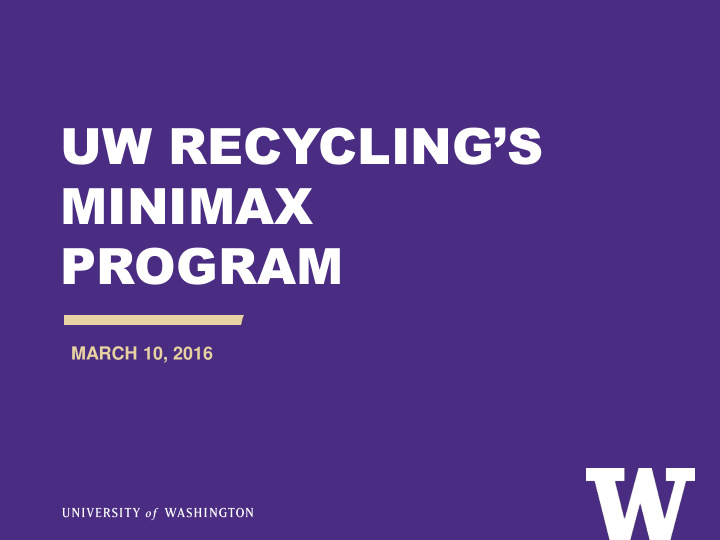



UW RECYCLING’S MINIMAX PROGRAM MARCH 10, 2016
THE UNIVERSITY OF WASHINGTON WELCOME TO THE UW > Covers 543 acres > Consists of 178 buildings > Over 11,300,000 cleanable gross square feet > Nearly 71,000 people come to campus each day
THE UNIVERSITY OF WASHINGTON UW RECYCLING’S ORGANIZATION CHART Custodial Services Facilities Building Services Services Dept. UW Recycling Some key campus partners includ e: • Housing & Food Services • University of Washington Medical Center • Intercollegiate Athletics • UW Sustainability
SNAPSHOT OF UW RECYCLING SERVICES > Collect waste and recycling from the main academic and facilities buildings. > Contract administrator for all recycling and solid waste contracts on the UW Seattle campus. > Coordinate compost and recycling outreach programs and events, including MiniMax .
SNAPSHOT OF UW’S WASTE 13,000 TONS GENERATED PER YEAR (66% WASTE DIVERSION RATE) Sample of Materials Generated/Collected Cans & Bottles Garbage Concrete Paper Construction & Demolition Scrap Metal Electronics/White Goods Styrofoam e.Media Toner Cartridges Fluorescent bulbs Wood Waste Food Waste Yard Waste
SNAPSHOT OF UW RECYCLING’S PROGRAMS > SCRAM: Student Moveout • Started in 2004; has kept over 100 tons of material out of the landfill. > Trash-In: Exploring the Way We Waste • Annual waste sorting event where staff, faculty & student volunteers sort through nearly 1,000 pounds of trash. > Football Bluebag Outreach • Distribute recycling bags throughout parking lots to football game attendees . > MiniMax • Existing deskside garbage cans are exchanged with self-service recycle and garbage containers. (No liners provided.)
WHAT IS MINIMAX? MINIMIZE WASTE; MAXIMIZE RECYCLING (AND COMPOST!) > Our approach to establishing a comprehensive office waste diversion program by • Providing centralized (custodial-serviced) Garbage compost/recycle/waste bins. • Composting restroom paper towels. Recycling
WHY COMPOST? THE DENNY PROJECT: THE FUTURE OF WASTE AT THE UW 6.7% % collected for recycling 7.3% % collected for compost 34% sent to 39% landfill % estimated compost sent to landfill recycled sent to % estimated garbage sent to landfill landfill 20% % estimated recycling sent to landfill *estimates based on Trash-In 2012 Report 27% composted
HISTORY OF MINIMAX 2010 – MiniMax became 2012 – Piloted restroom 2008 – Piloted 2015 – City ordinance standard for all new and at the UW Tower paper towel composting banning recycling & renovated buildings compost from landfill 2009 – Expanded program 2011 – Piloted public 2013 – The UW to voluntary buildings area composting Garbology (i.e. Program of the Project Environment, etc.)
UW GARBOLOGY PROJECT THE DENNY PROJECT: THE FUTURE OF WASTE AT THE UW
UW GARBOLOGY PROJECT RESULTS > An increase in waste diversion by 10 percentage points: 42.6% to 52.5% > 83 fewer annual landfilled-tons > 3.5% lower waste disposal costs
MINIMAX TODAY MiniMax Installation Progression 101 total buildings 45 40 converted to MiniMax 40 YTD 35 35 30 25 25 20 15 # of Buildings 10 5 1 0
SUCCESSES
MINIMAX: PROGRAM SUCCESS INCREASED COLLABORATION • Internal meetings with Custodial Services. Education / Outreach • Conversations with Building Coordinator / Department Admins. • Present MiniMax information to affiliated groups. Planning • Complete site visit(s) with custodial staff and building occupants. • Coordinate installation with UWR staff, Building Coordinator, Custodial Services. Implementation • Adjust exterior service levels with UWR crew and Cedar Grove. • Seek feedback from Custodial Services staff • Survey building occupants; measure effectiveness of program. • Analyze loading dock containers; adjust service level as needed. Evaluation
MINIMAX: THE SUCCESSES IMPROVED EDUCATIONAL MATERIALS
MINIMAX: THE SUCCESSES INCREASED COMPOST DIVERSION Compost Compos t collected fr collected from UW om UW Academic & Facilit Academic & F acilities buildings ies buildings 600.00 500.00 488.5 400.00 Tons ons 300.00 321.9 200.00 123.9 100.00 0.00 FY2013 FY2014 FY2015
MINIMAX: THE SUCCESSES INVESTMENT = SAVINGS $800,000 $700,000 $600,000 $500,000 $400,000 FY14 FY15 $300,000 $200,000 $100,000 $0 $0 Cost t of Conta tainers rs Compost t Collecti tion Disposal Cost Cost Sa Savings
MINIMAX: THE SUCCESSES IMPROVED INFRASTRUCTURE & SIGNAGE > Increased accessibility to recycling and composting . • Consistency in centralized container type/size/quantity/locations. > Added awareness / education on what goes where • Illustrated signage placed on all containers.
MINIMAX: THE SUCCESSES INCREASED OVERALL WASTE DIVERSION 70% 66% 61% 61% 59% 60% 59% 54% 52% 52% 50% 42% 40% 29% 30% 21% 20% 10% 1% 0% 2008 2009-2011 2012 2013 2014 2015 % MiniMax % Waste Diversion
CHALLENGES
MINIMAX: THE CHALLENGES > Low-hanging fruit has been picked. > Compost carrot (incentive) has been removed. > Staffing issues within Custodial Services impacts overall labor hours redirected.
MINIMAX: THE CHALLENGES Total T otal Tons ons of of Material terial Gener enerated ted By By Campus Campus Group oup 4000 3500 854 3000 2500 Landfilled Tons 77% 2000 Diversion Diverted Tons Rate 2832 1500 1000 376 778 68% 39% % Diversion 500 70% Diversion iversion Rate 787 123 Diversion Rat ate 487 Rate 293 0 Academic/Facilities HFS ICA UWMC
THE FUTURE OF MINIMAX > Conduct pilot where deskside containers are not placed in offices (at all). > MiniMax is no longer voluntary and serves as the deskside standard for ALL buildings on campus. > 100% of campus is converted. > Waste Diversion goal of 70% by 2020 is reached.
THANK YOU HAVE QUESTIONS? Emily Newcomer (206) 685-2811 emilyn2 @ uw.edu Erica Bartlett (206) 543-0443 ericab8 @ uw.edu
Recommend
More recommend